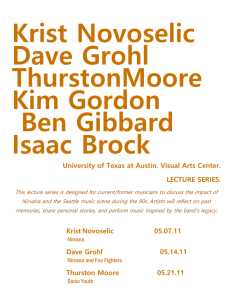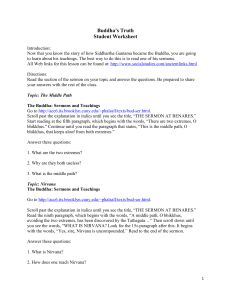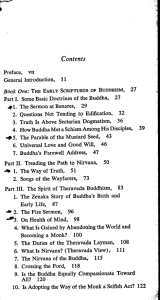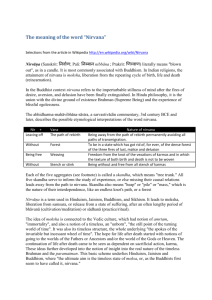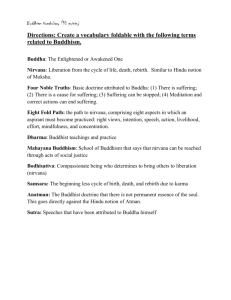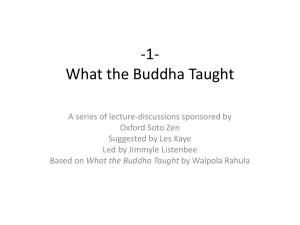Does Buddhism Teach that the World is Evil?
advertisement
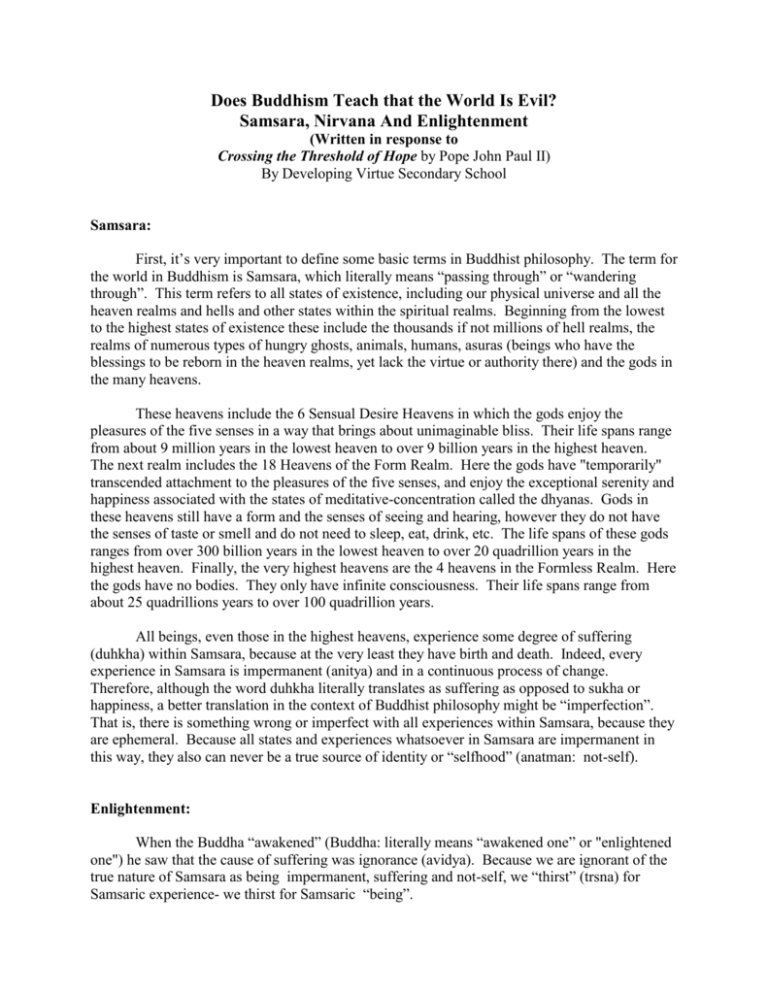
Does Buddhism Teach that the World Is Evil? Samsara, Nirvana And Enlightenment (Written in response to Crossing the Threshold of Hope by Pope John Paul II) By Developing Virtue Secondary School Samsara: First, it’s very important to define some basic terms in Buddhist philosophy. The term for the world in Buddhism is Samsara, which literally means “passing through” or “wandering through”. This term refers to all states of existence, including our physical universe and all the heaven realms and hells and other states within the spiritual realms. Beginning from the lowest to the highest states of existence these include the thousands if not millions of hell realms, the realms of numerous types of hungry ghosts, animals, humans, asuras (beings who have the blessings to be reborn in the heaven realms, yet lack the virtue or authority there) and the gods in the many heavens. These heavens include the 6 Sensual Desire Heavens in which the gods enjoy the pleasures of the five senses in a way that brings about unimaginable bliss. Their life spans range from about 9 million years in the lowest heaven to over 9 billion years in the highest heaven. The next realm includes the 18 Heavens of the Form Realm. Here the gods have "temporarily" transcended attachment to the pleasures of the five senses, and enjoy the exceptional serenity and happiness associated with the states of meditative-concentration called the dhyanas. Gods in these heavens still have a form and the senses of seeing and hearing, however they do not have the senses of taste or smell and do not need to sleep, eat, drink, etc. The life spans of these gods ranges from over 300 billion years in the lowest heaven to over 20 quadrillion years in the highest heaven. Finally, the very highest heavens are the 4 heavens in the Formless Realm. Here the gods have no bodies. They only have infinite consciousness. Their life spans range from about 25 quadrillions years to over 100 quadrillion years. All beings, even those in the highest heavens, experience some degree of suffering (duhkha) within Samsara, because at the very least they have birth and death. Indeed, every experience in Samsara is impermanent (anitya) and in a continuous process of change. Therefore, although the word duhkha literally translates as suffering as opposed to sukha or happiness, a better translation in the context of Buddhist philosophy might be “imperfection”. That is, there is something wrong or imperfect with all experiences within Samsara, because they are ephemeral. Because all states and experiences whatsoever in Samsara are impermanent in this way, they also can never be a true source of identity or “selfhood” (anatman: not-self). Enlightenment: When the Buddha “awakened” (Buddha: literally means “awakened one” or "enlightened one") he saw that the cause of suffering was ignorance (avidya). Because we are ignorant of the true nature of Samsara as being impermanent, suffering and not-self, we “thirst” (trsna) for Samsaric experience- we thirst for Samsaric “being”. When ignorance ceases, then the thirst for Samsaric being “naturally” fades away. With the total cessation of ignorance and this thirst, Samsara is gone- there is only Nirvana. Indeed, Samsara itself is a distortion of Nirvana created by ignorance. We could say that we “misexperience” Nirvana as Samsara because of ignorance. A unique teaching of the Buddha is that this ignorance has no cause. There is no reason for it and it has no beginning in space or time. The analogy for the causeless nature of ignorance is explained via the story of Yajnadatta told by the Buddha in the Shurangama Sutra. Yajnadatta lived in India during the time of the Buddha. One day he looked in a mirror and fell in love with his reflection. However, he thought the head in the mirror belonged to someone else; that he did not have a head of his own. He suddenly went insane, and ran about madly screaming, "Where is my head! Where is my head!" The Buddha said, "Was there any reason why he became fearful for his head and ran madly about? If his madness were to suddenly cease, it would not be because he "recovered" his head from someplace outside. So even before his madness ceased, how could his head have been lost? Falseness is the same way. How can it exist? All you need do is not follow discriminations, because none of the three causes (mark of ignorance-karma, false subjectivity and objective states) arises when the three conditions of the three continuities of the world, living beings and karmic retribution are cut off. Then the madness of the Yajnadatta in your own mind ceases of itself, and just that ceasing is Bodhi (Enlightenment). The supreme, pure, bright mind originally pervades all reality. It is not something obtained from anyone else... ...Yajnadatta's head was naturally there, it was a natural part of him. There never was a time when it was not. Why, then, did he suddenly fear that he had no head and start running about madly? If he naturally had a head and went mad due to some causes and conditions, would it not be just as natural for him to lose his head due to causes and conditions? Basically his head was not lost. The madness and fear arose from falseness. There was never any change that took place." Nirvana: Nirvana is the true nature of reality, or perhaps more accurately, the true reality or “unconditioned” reality. Nirvana is usually described in terms of what it is not. The following are passages from the Buddhist Sacred Texts (Sutras) concerning Nirvana. "There is, monks, that realm, wherein there is no earth, no water, no fire, no air, no Sphere of Infinite Space, no Sphere of Infinite Consciousness, no Sphere of Nothingness, no Sphere of Thought nor Non-Thought (these are the 4 heavens in the Formless Realm). There is not this world or a world beyond, or both together, or sun or moon. This, I say, monks, has no coming, no going, no staying, no passing away, and no arising; without support, without duration and without any basis. This, indeed, is the end of suffering." (From Udana, Pataligamiya Vagga, Sutra No. 1) Upasiva: “Master you have the eyes that see everything. If this man stays many years in this state without returning, Will he be cooled and freed there itself? Say whether consciousness will still exist for such a person.” The Buddha: “Just as a flame is blown out by the force of the wind, Disappears and can no longer be reckoned, In the same way the Muni (Silent Sage) who has relinquished mentality and the body Disappears and can no longer be reckoned. Upasiva: “The man who has gone to rest, is he no more or is he forever free from illness?” The Buddha: “Having gone to rest there is no measure of him. That by which he can be spoken of does not exist. When all dharmas (things) are removed, Then all ways of speaking of him are also removed." (From Sutta-Nipata 1073-1076, note that this does not mean that the person who realizes Nirvana does not exist after death, rather that their state is indescribable.) "Whatever Bhikshu is an Arhat, free from outflows,*1 who has lived the life, done what was to be done, laid down the burden, attained his ideal, whose fetters to “being” are destroyed, who is freed by the highest knowledge.... He knows Nirvana as Nirvana. Because he knows Nirvana as Nirvana, he does not think of Nirvana. He does not think of himself in Nirvana. He does not think of himself as Nirvana. He does not think “Nirvana is mine”. He does not rejoice in Nirvana. Why? I say it is because it is thoroughly understood by him." *1 outflows in Sanskrit is asrava. There are four asravas: sensual desire (kama), existence (bhava) , views (drsti) and ignorance (avidya). (From Majjhima-Nikaya I, 4) The main point in these passages, which cannot be overemphasized, is the utmost “ineffability” of Nirvana. It cannot be truly described in words or speech, or conceived in thought. Even the holy sage who has realized Nirvana, as noted in the above Sutra passages, does not think of Nirvana in anyway. This is because it is not possible to think of Nirvana. A holy sage, one who awakens to Nirvana, does so here and now during his present life. Although he knows Nirvana, he is still also aware of what for him now is the “unreal” or “illusory” Samsara, and he will continue to do so until his present physical-psychological existence comes to its natural end at death. Then he realizes Nirvana “without residue”. The Bodhisattva and the Buddha's Nirvana: However, in our path, the Mahayana (the Great Vehicle), the Bodhisattva makes a vow to always remain in Samsara to help all beings become awakened. Therefore, these holy enlightened Bodhisattvas operate in a realm that is very difficult for common people to really understand. Although the Bodhisattva has done away with ignorance and sees the illusory nature of Samsara and the true reality of Nirvana (remember, "ultimately" there is only Nirvana), yet the Bodhisattva, due to his vows of compassion, courses in Samsara to help living beings until all beings are awakened. He is well aware that what he knows and experiences as being unreal and illusory (Samsara) is, due to ignorance, experienced as quite real and substantial to common living beings. "Disciples of the Buddha, all Buddhas, Tathagatas, because they wish to bring happiness to living beings, appear in the world. And because they wish to cause living beings to yearn for them they manifest Nirvana. Yet in reality, the Tathagata does not come into the world nor does he enter Nirvana. Why? The Tathagatas forever abide in the Pure Dharma Realm; yet in accordance with the minds of living beings he manifests Nirvana. Disciples of the Buddha, it's analogous to when the sun comes out. It shines everywhere throughout the world. Within all pure water vessels, it's reflection appears within them all. It reaches all these places everywhere, yet it does not come or go. If a vessel is broken, however, it's reflection will not appear in it. Disciples of the Buddha, what do you think? Is it the case that its reflection not appearing in those broken vessels is the fault of the sun?" They answered, "No. It's only because those vessels are broken. It is not the fault of the sun." "Disciples of the Buddha, the wisdom-sun of the Tathagata is also like this. It appears everywhere in the Dharma Realm. It is without before of after. Within the pure mind-vessels of all living beings, the Buddha appears in them all. The mind-vessels that are always pure always see the Buddha's body. If the mind is turbid and the vessel is broken, then they will not see him. Disciples of the Buddha, if there are living beings who can be saved by means of Nirvana, then the Tathagata for their sakes manifests Nirvana. Yet in reality the Tathagata is without birth and death. So he does not enter Nirvana ... Disciples of the Buddha, the Tathagata's body has no location. It is neither false or real. It is only by the power of the Buddha's original vows that when living beings can be rescued he then appears. The Bodhisattva, Mahasattva should understand the Great Nirvana of the Tathagata, the Worthy One of Right and Equal Enlightenment, in this way. Disciples of the Buddha, the Tathagata dwells in the measureless, unobstructed, ultimate Dharma-realm (Dharma-dhatu) with no origination and no cessation- Ultimate Reality. For the sake of living beings he appears according to the opportunity. Because of the original vows he upheld, he never rests and doesn't forsake living beings or worlds or dharmas." Flower Adornment (Avatamsaka) Sutra, Chapter 37, Manifestations of the Tathagata Conclusion: With this outlook it would not be accurate to say that Buddhism looks upon the world as particularly evil. Ultimately there is only Nirvana which is the goodness that transcends the duality of good and evil. I would also dare say that ultimately Buddhism cannot be said to be theistic or atheistic. The true, unconditioned reality, Nirvana, can be realized and experienced, but it cannot be thought of or described in anyway whatsoever. All mental constructs, thoughts, descriptions etc. are the creations of the Samsaric mind. Even the words I’ve used thus far in giving some indication of Nirvana are only the “finger pointing to the moon”. The finger in no way should be mistaken for the moon itself. Thus we can understand why the Buddha exhorted each individual to “come and see” for himself the truth of his teachings by personally cultivating the “path”. Only when one walks the path himself, with its three aspects of morality, meditative-concentration, and transcendent wisdom, can one see via direct experience what is true and real for oneself. A further note on the “path”: Nirvana is realized when one sees, via the path, the true nature of Samsara as being impermanent, suffering and not-self on a very profound level. With this deep and profound wisdom (prajna) that sees with laser-light clarity the true nature of Samsara, the thirst for Samsaric being naturally fades away. With the total fading away of this thirst for Samsara, Samsara itself fades away and Nirvana is revealed- Nirvana is realized. The words “revealed” and “realized” are chosen carefully. One can not say Nirvana is “produced by” or is a “result of” the extinction of ignorance and the thirst for Samsaric existence. Nirvana is neither a cause nor an effect, and it has no origination or cessation.

